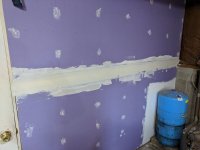Kubstix
Member
Hello everyone. Just had my well pump go a month or so ago and now I am back in business. However I am starting to exhibit issues with the plumbing around the pressure tank (leaking boiler drain, release valve nut, ect). I noticed my tank is 25+ years old as well as my plumbing and thought I would be proactive before I have my family as the money is here now. I have a few questions as I will be doing this myself.
1. PVC, Stainless, Or Brass for the entire setup? My tank is in my garage if location matters (fully insulated, garage doors sealed, and heated ever so slightly).
2. I currently have a WX-202 (20 gal). I plan on switching to a WX-202XL (26 gal). Is this OK and would it be better?
3. I am currently running on a 30/50 switch. Can I move to a 40/60?
4. What size is the black flexible well line for barb size fitting (house built in 1978)?
5. Can I do the same thing and use a 90 degree elbow barb fitting like previous owner did? I haven't noticed any issues currently. I highlighted the need for my elbow in the picture.
Thank You

1. PVC, Stainless, Or Brass for the entire setup? My tank is in my garage if location matters (fully insulated, garage doors sealed, and heated ever so slightly).
2. I currently have a WX-202 (20 gal). I plan on switching to a WX-202XL (26 gal). Is this OK and would it be better?
3. I am currently running on a 30/50 switch. Can I move to a 40/60?
4. What size is the black flexible well line for barb size fitting (house built in 1978)?
5. Can I do the same thing and use a 90 degree elbow barb fitting like previous owner did? I haven't noticed any issues currently. I highlighted the need for my elbow in the picture.
Thank You

